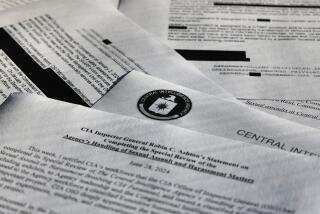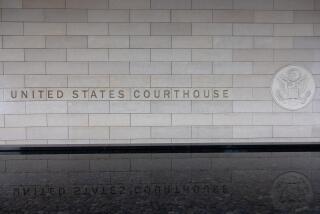Civilian Sues U.S., Says He Was Beaten, Kidnaped in Exercise
A civilian security officer at the Seal Beach Naval Weapons Station is suing the federal government for more than $6 million for an incident in which he was allegedly kidnaped and beaten during an exercise designed to test response to a terrorist attack.
Ronald Sheridan, 51, of Los Angeles and his wife, Margaret, filed the lawsuit in U.S. District Court in Los Angeles late Tuesday.
Kidnaped at Gunpoint
Sheridan alleges that a special Navy security team kidnaped him at gunpoint from his home in the Eagle Rock area of Los Angeles at 3 a.m. March 20, 1986, and drove him to a Costa Mesa motel, where, he says, he was beaten and held for about 28 hours.
The security officerâs attorney, Carl B. Pearlston Jr., said his client is a civilian and therefore should not have been subjected to such treatment as part of a military exercise. Sheridan, who is on a two-week vacation, could not be reached for comment Wednesday.
Navy officials, Pearlston said, have told the attorney that they consider Sheridan to have been a Navy employee. He said one official used the term âcrybabyâ to describe the security officerâs complaints.
But Sheridan was told that the exercise would be held only on the base and surrounding streets and that there would be no undue physical force used, Pearlston said. âThe Navy says the only limitation was they wouldnât break any bones or cut any flesh. That there would be no blood, in essence,â he said.
Base spokesman John Frye said Wednesday that the Navy will not comment on pending litigation. Frye did say an internal investigation is being conducted by the judge advocate generalâs office, the Navyâs legal department.
Frye said Sheridan is a civilian employee with the title of site security officer and is second-in-command of the civilian security force at the base.
Pearlston said the incident occurred during an exercise conducted by the security teams to see whether the base could be penetrated. The 12-day operation resulted in several infiltrations, placement of dummy explosives and occupation of several key areas.
Pearlston gave the following account:
Sheridan was informed in early March that the exercise would be held and was given some indication of how the exercise had been performed at other bases. At about 3:30 a.m. on March 20, he received a phone call at his home in Eagle Rock, calling him in to work. Although he believed it to be a hoax, he decided to drive to Seal Beach anyway, got dressed and went out to his car.
But when Sheridan walked outside, he was confronted by a man later identified as Frank Phillips, a member of the security team, who brandished a gun and told the security officer to get into his car. The man told Sheridan the exercise had begun and displayed a badge.
Sheridanâs wife saw the entire incident from her window. Believing it to be real, she rushed downstairs, armed herself with Sheridanâs .45-caliber handgun and started to go outside, Pearlston said. âShe got the gun and she was going to shoot this guy,â the attorney said. âFortunately, Sheridan saw her from the driveway and yelled out to her, âDonât shoot, itâs a security exercise.â â
Held in Costa Mesa
The gunman drove Sheridan, a former Los Angeles police officer, about a block where they got into a car driven by a second man, believed to be Arturo Farrias. Sheridan was blindfolded, handcuffed and driven to the Costa Mesa motel. There, two other men, believed to be Robert Holmes and Stephen Hartman, joined in and the group watched TV, napped and talked until about 5 p.m. Sheridanâs blindfold and handcuffs were removed at the motel.
Sheridan told the men that he wanted to go home but was refused a number of times. After receiving a phone call at 5 p.m., the men handcuffed him, placed a pillowcase over his head and told him he was going to be filmed. Shortly thereafter, other people came in and a floodlight came on.
A lot of shouting began, and Sheridanâs chair was knocked over so that he banged his head against the wall, after which he was stripped and his underwear was torn off. The men picked him up, bounced him upside down on his head and then dragged him into the bathroom, Pearlston said.
There, Sheridan was bounced off the sink, kicked and punched before being held upside down again. The men placed his head in the toilet bowl and flushed it several times. After that, he was held over the side of the bathtub with one man sitting on his back while the tub was filled, then shouted at and beaten while being dunked.
âWhat they were doing was simulating interrogation,â Pearlston said. âDuring this time, he made no sound and just remained limp, fearing he would be beaten further if he defended himself. He also inhaled some water. . . . At one point, he felt something popping in his rib cage and thought one of his ribs had snapped. But they didnât stop when he told them he thought he was injured.â
After the beating, during which no questions were asked, Sheridan was asked to identify himself and complied. He then asked to be examined by a doctor and X-rayed and was refused by the men. The man later identified as Farrias allegedly told him, âIf you donât shut up, weâll tie you up and gag you, and throw you into a closet.â
Over his continued protests, the suit claims, Sheridan was kept overnight at the motel without the requested medical assistance until he was taken to the base about 8 a.m. the next day.
The lawsuit states that Sheridan suffered mental and physical pain, including bruises, pinched nerves and a dislocated rib. He lost time from work and is undergoing physical therapy, Pearlston said.
In addition to the U.S. government, the lawsuit also names Capt. Richard Marcinko and Lt. Cmdr. Wellington Leonard, who conducted the operation; the Essex Corp., a firm that advises the government on test exercises, and the men who allegedly participated in the kidnaping and beating--Phillips, Farrias, Hartman, Holmes, and others identified as Kevin Shrat and Theodore Macklin, an Essex Corp. employee.
Pearlston said he filed a claim against the government last April and was required to give Navy investigators six months to conduct their own inquiry.
Times staff writer Tim Waters contributed to this story.
More to Read
Sign up for Essential California
The most important California stories and recommendations in your inbox every morning.
You may occasionally receive promotional content from the Los Angeles Times.










